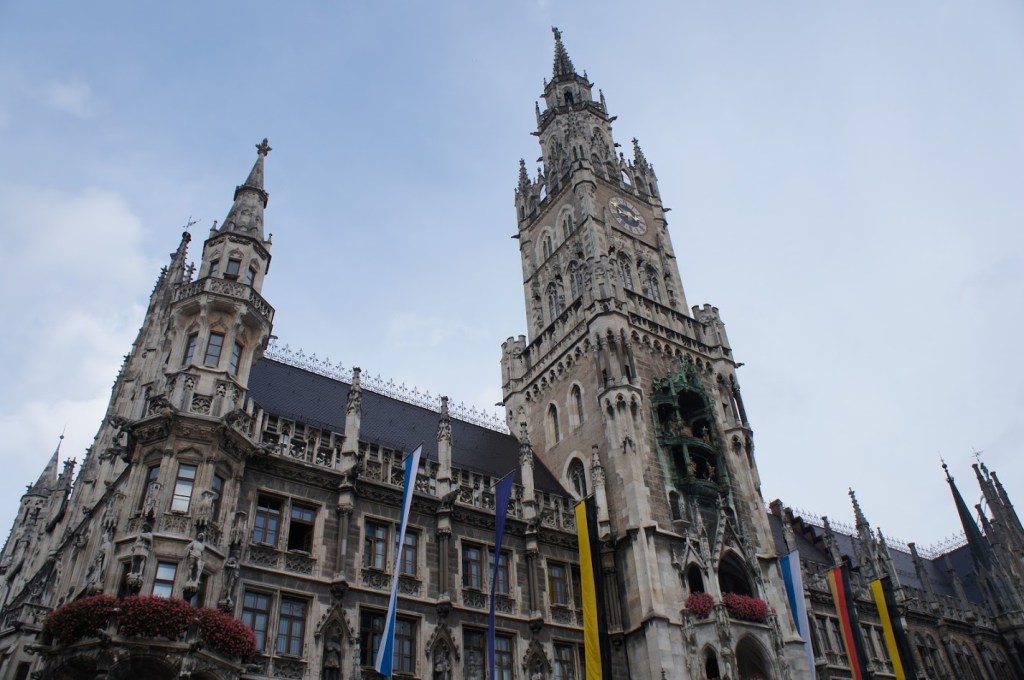Munich may not be as hip as Berlin, but my husband and I made a stopover in the Bavarian capital on our tour of Germany to take in some of its art, history and culture. Of course, my heart squealed at the fact that we were going to visit the most iconic castle in the world: Neuschwanstein Castle.
We arrived in Munich right in the middle of Oktoberfest, which – against most people’s instinctive guess of October – actually took place in September. We chanced upon many revellers fully decked out in lederhosen and dirndls as we made our way to our hotel from Munich International Airport. The festive atmosphere was everywhere in the city!
The historic core of Munich: Marienplatz
After checking into our hotel, we took a tram towards the central train station and made our way to Marienplatz on foot. As the city’s main town square, Marienplatz has been around since 1158, and this was where itinerant markets stalls have set up shop for centuries. Today, Munich’s main tourist attractions radiate from the Hauptbahnhof, and that’s precisely why we paid this place a visit.
We were fascinated by the lines of souvenir shops, fashion boutiques and food chains housed within the gothic and Renaissance-era architecture. After stocking up on some souvenirs for friends and family back home, we headed towards New Town Hall to catch the main attraction of the city, the Glockenspiel. Every day at 11 am and 12 noon, the figurines in the clock would start reenacting the Munich folklore of wedding, dancing and jousting tournament. The 15-minute show was so beautiful with the 43 different bells ringing different tunes.
While Marienplatz was a hubbub of activity, we decided to skip it and make a detour to some lesser-known sites nearby. And we didn’t regret it! I was blown away by the grandeur of St. Peter’s Church, a Baroque masterpiece dripping with decorative frescos and marble details.
And just a few lanes away was the monolithic travertine-clad Ohel Jakob synagogue. While closed to the public, its austere exterior was a sharp contrast to the surrounding neo-classical architecture. The first glimpse of Munich was full of old-age architecture that lasted through the generations — that certainly left both of us in awe.
St. Peter’s Church
Address: Rindermarkt 1
Operating hours: Monday – Friday, 9am – 6pm | Saturday – Sunday, 10am – 6pm
How to get there: Marienplatz is the nearest train station
Ohel Jakob Synagogue
Address: Sankt-Jakobs-Platz 18
Operating hours: Sunday – Friday, 8.30 am – 6 pm
How to get there: Marienplatz is the nearest train station
Fuelling up at Viktualienmarkt

When visiting a country, we love to immerse ourselves with the locals. One of the best ways to do that in Munich was to visit the Viktualienmarkt, a 19th-century market where locals haggled and bargained for their daily groceries. We couldn’t stop ourselves from filling our tummies with grilled-on-the-spot sausages and pretzels from several delis along the street. There were quite a variety of sausages on the menu, from skinless weisswurst to the more common bratwurst.
Within the market, we also came across a beer garden (Viktaulienmarkt 9, open Mon-Sat 9am-10pm) packed with locals and tourists drinking beer bought from one of the many self-service beer stalls. The stalls offered an alternating selection of beer on tap from Munich’s famed breweries. We just had to get ourselves some beer to quench our thirst!
Viktualienmarkt
Market: Monday – Saturday, 8 am – 6 pm
Beer garden: Monday – Saturday, 9 am – 10 pm
How to get there: Marienplatz is the nearest train station
Encountering surfers at Englischer Gardens

Our second day in Munich was filled with visits to the city’s art museums, but first, we hit the Englischer Gardens, Munich’s biggest green space, for their daily walks and general chill out sessions. Besides a couple of beer gardens and restaurants, we were surprised to discover a Japanese pagoda here. What caught our eyes, though, were the clutch of surfers riding the waves at the mouth of the Eisbach River. The casual and relaxed vibe was very prominent as we joined onlookers gawping at the wetsuit-clad surfers.

After we got our fill of Munich micro surfing scene, we strolled to the picturesque Hofgarten. Spotting a few cafes there, we decided to pick a table under a tree to have an early lunch of pork knuckle sandwiches and beer.
Englischer Gardens
Operating hours: Daily, 24 hours
How to get there: Alight at Odeonsplatz or Universitat if you are taking U-bahn, or take bus 100 to Haus der Kunst.
Hofgarten
Address: Hofgartenstrasse 1
Operating hours: open 24 hours
How to get there: Take U-bahn to Odeonsplatz
Getting our fill of modern art and design

From there, we walked to the Pinakothek der Moderne. As one of the recommended art museums in Germany, we included this in our itinerary as it houses masterpieces by modern artists like Pablo Picasso, Joan Miro, Henri Magritte and Paul Klee. We were surprised to find the large contemporary glass-fronted building. The light-filled interior was sparsely laid out with well-spaced-out exhibits. We wandered through the cavernous art gallery on the upper levels, all while marvelling at the stark all-white interiors.

On the lower levels of the Pinakothek is Die Neue Sammlung – The Design Museum. This section of the museum was surprisingly enjoyable! There was an informative walk-through of the history of industrial design that catalogued the invention of iconic products, from the telephone and the radio to sofas and cars.
Pinakothek der Moderne
Address: Barer Strasse 40
Operating hours: Tuesday – Sunday, 10 am – 6 pm
How to get there: The nearest U-bahn station is Odeonsplatz, or you can take bus 58 or 100 to Pinakotheken.
A museum where old meets new
After Pinakothek der Moderne, we took another leisurely stroll to the Lenbachhaus. Housed within a former villa, the museum sports a futuristic-looking entrance designed by renowned architect Norman Foster. Beyond the cube-like entrance, the interior is a carefully preserved Florentine-style space punctuated by contemporary art. We came here to see the exhibition dedicated to The Blue Rider group of artists – as the Lenbachhaus contains the world’s most extensive collection of pieces from the group. Consisting of Wassily Kandinsky, Alexej von Jawlensky, Marienne von Werefkin and more, the group is known for their colourful expressionist works.

Lenbachhaus
Address: Luisenstrasse 33
Operating hours: Tuesday – Sunday, 10 am – 6 pm
How to get there: Alight at Konigsplatz either via U-bahn or bus 58 or 100.
After viewing all the evocative artworks, we discovered the museum’s peaceful inner garden. Dotted with a handful of contemporary sculptures and some lawn chairs, we kicked up our heels for a well-deserved rest as we allowed our two days in Munich to sink in. The next day, we would take the train out of Munich and into the Bavarian countryside of Schwangau to visit Neuschwanstein Castle and its sibling Hohenschwangau Castle.
Practical Info
Where to stay in Munich
Though located a little further away from Marienplatz and the museums, Hotel Europa is a modern and affordable option, with a nice garden courtyard and hot breakfast
Munich by public transport
Munich International Airport is connected to the city via the S-Bahn network. We took the S8 S-Bahn train to the main train station, the Hauptbahnhof, and transferred to the tramway network to get closer to our hotel on Dauchauer Strasse. The overground Münchener Verkehrsgesellschaft (MVG) tram system is a convenient way to get closer to some main attractions, including Marienplatz (20) and the Pinakothek (28). The city is compact enough to walk from site to site, just remember to plan your route and wear comfortable shoes!
Thanks for reading the article. Share if you enjoyed!
Source link







